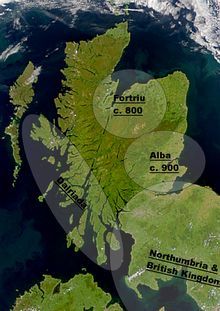
Back Koninkryk Alba Afrikaans Alba krallığı Azerbaijani Каралеўства Альба Byelorussian Regne d'Alba Catalan Alba (království) Czech Βασίλειο της Άλμπα Greek Reino de Alba Spanish Albako Erresuma Basque Alban kuningaskunta Finnish Alba (royaume) French

The Kingdom of Alba (Latin: Scotia; Scottish Gaelic: Alba) was the Kingdom of Scotland between the deaths of Donald II in 900 and of Alexander III in 1286. The latter's death led indirectly to an invasion of Scotland by Edward I of England in 1296 and the First War of Scottish Independence.
Alba included Dalriada, but initially excluded large parts of the present-day Scottish Lowlands, which were then divided between Strathclyde and Northumbria as far north as the Firth of Forth. Fortriu, a Pictish kingdom in the north, was added to Alba in the tenth century.
Until the early 13th century, Moray was not considered part of Alba, which was seen as extending only between the Firth of Forth and the River Spey.[1]
The name of Alba is one of convenience, as throughout this period both the ruling and lower classes of the kingdom were predominantly Pictish-Gaels, later Pictish-Gaels and Scoto-Normans. This differs markedly from the period of the House of Stuart, beginning in 1371, in which the ruling classes of the kingdom mostly spoke Middle English, which later evolved into and came to be called Lowland Scots. There is no precise Gaelic equivalent for the English term "Kingdom of Alba", as the Gaelic term Rìoghachd na h-Alba means 'Kingdom of Scotland'. English-speaking scholars adapted the Gaelic name for Scotland to apply to a particular political period in Scottish history, during the High Middle Ages.
- ^ Broun, Dauvit (2007). Scottish Independence and the Idea of Britain From the Picts to Alexander III. Edinburgh: Edinburgh University Press. p. 7. ISBN 9780748623617.
© MMXXIII Rich X Search. We shall prevail. All rights reserved. Rich X Search